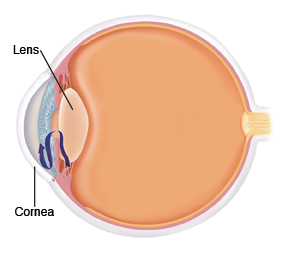Chronic Open-Angle Glaucoma

The eye is a fluid-filled globe with a lens near the front and a light-sensitive screen in the back (retina). The optic nerve conducts light signals from the retina to the brain. It allows you to see. Eye fluid is constantly being made and spread throughout the eye. Excess fluid drains out into the bloodstream.
Open-angle glaucoma is when the fluid pressure in the eye slowly increases and damages the optic nerve. This causes a gradual loss of vision over months to years. It may progress to complete blindness if not treated. The cause of glaucoma is not known. It may be inherited.
Open-angle glaucoma is painless. The first symptoms may be loss of side (peripheral) vision. Or you may have no symptoms at all. Many times the symptoms appear later in the disease. So you may have a lot of vision loss before you become aware of the problem. The vision loss is permanent and can't be reversed.
Open-angle glaucoma can be treated to hopefully prevent damage to the optic nerve and vision loss. It can be treated with eye drops, pills, surgery, and laser treatment. These help to reduce the pressure in the eye. Treatment is often successful at keeping pressures low and preventing more vision loss. This condition can’t be cured, so it's important to get treatment as prescribed for the rest of your life. Regular follow-up care with an eye care provider is very important to check your response to treatment.
Home care
-
Take medicines exactly as prescribed.
-
The eye needs certain vitamins and minerals for good health—especially vitamins A, C, and E, as well as zinc and copper. Eat a healthy diet full of fruits and vegetables to be sure that you get enough of these nutrients. If you have trouble following a balanced diet, think about taking a vitamin and mineral supplement.
-
Drink 6 to 8 glasses of water in smaller amounts during the course of a day. Drinking too much at a time (more than 1 quart) may increase eye pressure.
-
Limit the amount of caffeine that you drink to moderate levels.
-
Regular exercise (3 times a week) may help reduce eye pressure. Stay away from exercise positions that put your head below your waist (such as bending over). This position will increase eye pressure. Talk with your health care provider about an exercise program that’s right for you.
-
Protect your eyes. An eye injury can cause increased eye pressure. Wear safety glasses or goggles when you play sports, use tools or machinery, or work with chemicals.
Follow-up care
Follow up with your eye care provider, or as advised. Regular appointments will help make sure that your treatment is keeping your eyes at a safe pressure.
Open-angle glaucoma tends to run in families. Other family members older than age 40 should also be examined by an eye care provider.
When to get medical care
Get medical care right away if any of the following occur:
Online Medical Reviewer:
Daphne Pierce-Smith RN MSN
Online Medical Reviewer:
Sravani Chintapalli Researcher
Online Medical Reviewer:
Whitney Seltman MD
Date Last Reviewed:
4/1/2025
© 2000-2025 The StayWell Company, LLC. All rights reserved. This information is not intended as a substitute for professional medical care. Always follow your healthcare professional's instructions.